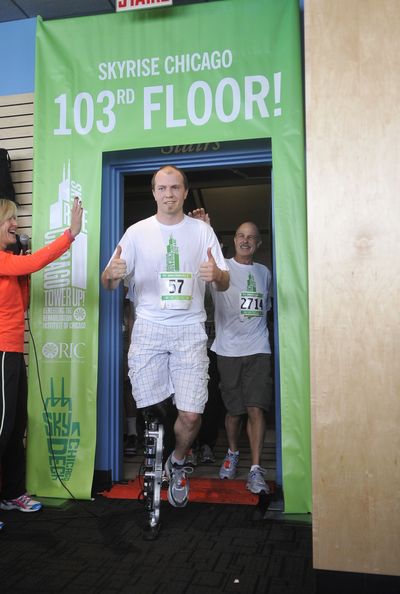Bionic man climbs skyscraper
103-floor ascension tests prosthetic leg

CHICAGO – The metal on Zac Vawter’s bionic leg gleamed as he climbed 103 floors of Chicago’s iconic Willis Tower, becoming the first person ever to complete the task wearing a mind-controlled prosthetic limb.
Vawter, who lost his right leg in a motorcycle accident, put the smart limb on public display for the first time during an annual stair-climbing charity event called “SkyRise Chicago” hosted by the Rehabilitation Institute of Chicago, where he is receiving treatment.
“Everything went great,” Vawter said at the event’s end. “The prosthetic leg did its part, and I did my part.”
The robotic leg is designed to respond to electrical impulses from muscles in his hamstring. When Vawter thought about climbing the stairs, the motors, belts and chains in his leg synchronized the movements of its ankle and knee.
The computerized prosthetic limb, like something one might see in a sci-fi film, weighs about 10 pounds and holds two motors.
Bionic – or thought-controlled – prosthetic arms have been available for a few years, thanks to pioneering work done at the Rehabilitation Institute. Knowing that leg amputees outnumber people who’ve lost arms and hands, the Chicago researchers are focusing more on lower limbs. If a bionic hand fails, a person drops a glass of water. If a bionic leg fails, a person falls down stairs.
This event was a research project, said Joanne Smith, the Rehabilitation Institute’s CEO.
“We were testing the leg under extreme conditions. Very few patients who will use the leg in the future will be using it for this purpose. From that perspective, its performance was beyond measure,” Smith added.
Vawter said that to prepare for his pioneering climb, he practiced on a small escalator at a gym, while researchers spent months adjusting the technical aspects of the leg to ensure that it would respond to his thoughts.
When Vawter goes home to Yelm, Wash., where he lives with his wife and two children, the experimental leg will stay behind in Chicago. Researchers will continue to refine its steering. Taking it to the market is still years away.
“We’ve come a long way, but we have a long way to go,” said lead researcher Levi Hargrove of the institute’s Center for Bionic Medicine. “We need to make rock-solid devices, more than a research prototype.”
The $8 million project is funded by the U.S. Department of Defense and involves Vanderbilt University, the Massachusetts Institute of Technology, the University of Rhode Island and the University of New Brunswick.
“A lot of people say that losing a leg is like losing a loved one,” Vawter said. “You go through a grieving process. You establish a new normal in your life and move on. Today was a big event. It’s just neat to be a part of the research and be a part of RIC.”
Nearly 3,000 people attended the annual stair-climbing event. Participants climbed 103 floors – about 2,100 steps in all – to the Willis Tower’s SkyDeck level.
Organizers said the event raises about $1 million each year to support rehabilitation care and research at the institute.